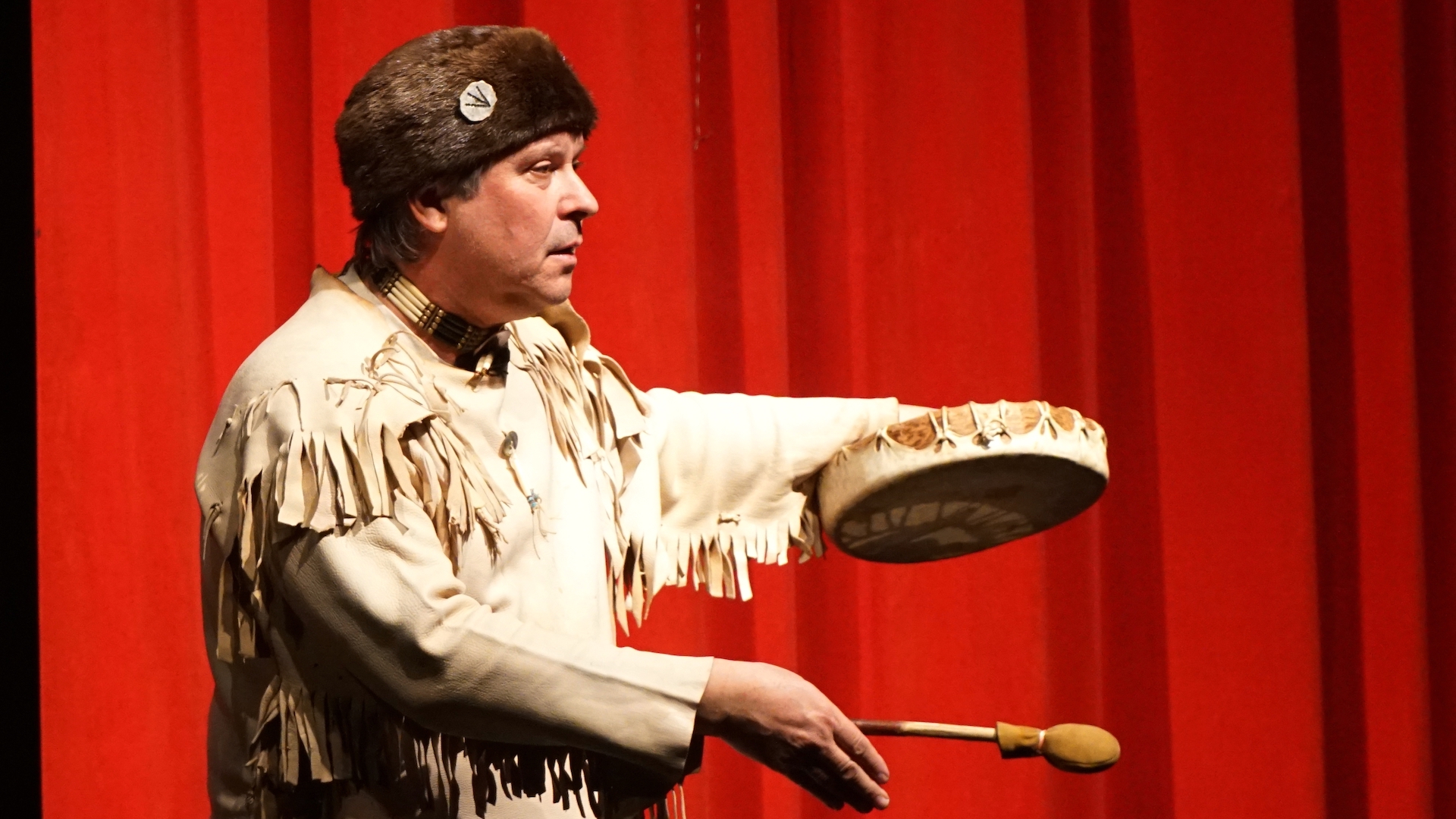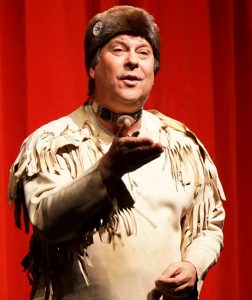
Event details
- Tuesday | March 16, 2021 to Wednesday | March 31, 2021
- All Day
- Zoom - see link in text below
- (864) 244-1499
View Map | Cost: Free
Black Hawk’s View of American History, Presented by Brian “Fox” Ellis
This event has concluded. You can view the recording of this show by clicking below. The recording is available until March 31, 2021 only.
For additional materials about Fox Tales International and the Brian “Fox” Ellis shows: Foxtalesint.com
Fox Tales pod casts: www.youtube.com/c/foxtalesinternational
by Fox: StoriesWeTell
Fox Books to Buy: FoxTalesBooks4Sale
Imagine sitting around a campfire with Ma-ka-tai-me-she-kiuk-kiuk, Black Hawk, listening to the stories of creation and the legends of his grandfathers. Storyteller and historian Brian “Fox” Ellis begins the program with his family’s connection to the Trail of Tears and the forced removal of the Cherokee Nation from their ancestral homeland in the Carolinas. Using this personal history and a deep knowledge of Native American history this intimate story builds a bridge, bringing the audience on a journey back into those dark days of American History with both humor and real insight, drawing strength from the resilience of the people. The audience is then led down the path through time to an encounter with Black Hawk’s Band on the eve of the battle. Two-thirds of the show is drawn directly from Black Hawk’s Autobiography. Fox then seamlessly becomes the reporter who transcribed and published Black Hawk’s life story. Weaving true history with folklore to create a tapestry of symbolic language he draws the audience into the world view of this respected leader of his people. There are traditional chants and drumming songs, including a chance for the audience to sing-a-long, and celebrate the First Nations of this land, and to begin to see the world through Native eyes.
 Brian “Fox” Ellis
Brian “Fox” Ellis
Brian “Fox” Ellis is a storyteller, historian, and author of 30 books and 100 articles He is also a museum consultant who presents more than 300 programs a year at schools, conferences, museums, Chautauqua, libraries and theaters around the world. He is of Cherokee descent, performs at powwows, and has written this program with the blessings of Sauk Elders. He has been one of the more popular speakers on the Chautauqua circuit from Colorado to South Carolina and he has been listed with the Illinois Humanities Roads Scholars program for a dozen years. Fox has recently launched a tv series on PBS called History In Person in which he presents more than a dozen chautauqua style programs. Many of you may remember him as Meriwether Lewis. He also has a podcast and YouTube channel, Fox Tales International. For more information please visit www.foxtalesint.com.
In 2016 Brian performed for Greenville Chautauqua as Meriwether Lewis.

Black Hawk, Indian name Ma-ka-tai-me-she-kia-kiak, (born 1767, Saukenuk [now in Rock Island, Illinois]—died October 3, 1838, village on the Des Moines River, southeastern Iowa Territory [now in northeastern Davis county, Iowa]), leader of a faction of Sauk, Fox, Kickapoo, and Ho-Chunk (Winnebago) peoples. Black Hawk and his followers contested the disposition of 50 million acres (20 million hectares) of territory that had supposedly been granted to the United States by tribal spokesmen in the Treaty of St. Louis in 1804. His decision to defy the government and attempt to reoccupy tribal lands along the Rock River in Illinois resulted in the brief but tragic Black Hawk War of 1832.
Antagonistic to whites settling in his people’s territory, Black Hawk joined the British in a number of engagements in the War of 1812. (This action and an ongoing relationship with the British in Canada would earn Black Hawk and his followers the sobriquet the “British Band.”) Thereafter U.S. officials cultivated the cooperation of Keokuk, a rival chief, who took what Black Hawk saw as an accommodationist approach to the government’s demands that the Sauk and Fox honour the treaty of 1804 and resettle across the Mississippi River in what is now Iowa. Black Hawk became the leader of dissident Sauks and Foxes who refused to acknowledge the legitimacy of the treaty.
In 1832 Black Hawk, who had been compelled to relocate to Iowa in 1830, led some 1,000 Sauks, Foxes, and Kickapoos—including women and children—back across the Mississippi to the disputed Illinois area with the intention of resettling there. Gov. John Reynolds of Illinois called out the militia, and the U.S. government also dispatched troops to confront the band.
Black Hawk and his followers easily repulsed the Illinois militia in the war’s first encounter, the Battle of Stillman’s Run, and the Indians fared well in a number of other early conflicts. As the weeks wore on, however, the strength of Black Hawk’s band began to wane. Expected aid from other tribes and the British did not materialize, food supplies were quickly exhausted, and desertions, malnutrition, and illness took their toll. Black Hawk retreated northward through the Rock River valley, and in the final battle, or massacre, at the Bad Axe River in what is now Wisconsin, most of the Indians, who were trying to make their way back across the Mississippi, were slaughtered. Black Hawk escaped but surrendered shortly thereafter. As a condition of peace, the United States dispossessed the Sauk and Fox of their land in eastern Iowa and the Ho-Chunk of theirs in southern Wisconsin. The ruthlessness of the Black Hawk War so affected Native Americans that by 1837 all surrounding tribes had fled to the West, leaving most of the former Northwest Territory to white settlement.
Black Hawk and most of the other chiefs and leaders of the band remained in custody after the war. In September 1832 Jefferson Davis, a young army lieutenant, accompanied the prisoners by steamboat to Jefferson Barracks in St. Louis, Missouri, where they were confined, often in chains, throughout the fall and winter. Their visitors included the celebrated author Washington Irving and the artist George Catlin, who made a number of paintings and sketches of them, some of which portrayed them (at their own insistence) in chains. The following spring, five of these men were turned over to Keokuk.
After seven months in captivity, Black Hawk and five others were sent east in April 1833. Their first major stop was Washington, D.C., but their final destination was another prison, Fort Monroe in southeastern Virginia. Traveling from St. Louis to Washington by steamboat, carriage, and railroad, they attracted huge crowds wherever they went. In Washington, they met with Pres. Andrew Jackson and Secretary of War Lewis Cass. Even before they left Washington for Fort Monroe, Cass was already inclined to send them home. As a result, they stayed just a few weeks at the fort, where they spent much of their time sitting for paintings and sketches by various artists.
On June 5, 1833, Black Hawk and the others were loaded on a steamboat for the trip west. To impress upon them the number and strength of the American people, Cass directed that they be taken on a route that included most of the large cities of the East—Baltimore, Maryland, Philadelphia, and New York—before heading west over the Erie Canal and Great Lakes. Everywhere they went in the East, they met with immense crowds that were anxious to see and hear them. This public enthusiasm did not extend to the west; in Detroit an angry crowd hanged and burned effigies of the prisoners. In mid-July the first of the prisoners were released at Prairie du Chien, Wisconsin. The remaining four were held at Fort Armstrong on Rock Island until Keokuk and other Sauk and Fox leaders could come to take charge of them in early October. Black Hawk’s release to Keokuk was a final blow to his pride, from which he never recovered.
During these final days of his captivity at Fort Armstrong, Black Hawk recounted the story of his life for Antoine LeClair, a mixed-race interpreter, and J.P. Patterson, a newspaper editor. Before the end of the year, they had edited and published Life of Ma-Ka-Tai-Me-She-Kia-Kiak or Black Hawk. While its authenticity was questioned at the time, it is generally accepted now as Black Hawk’s autobiography. But it should not be viewed as entirely accurate—either as an account of events or as a record of Black Hawk’s understanding of those events. What Black Hawk said to LeClair and Patterson is very likely not precisely what appeared in the book. His words were translated from Sauk into English by LeClair and then written down by Patterson. The raw transcripts of these conversations do not survive, but it seems likely that Patterson edited and rearranged the material with an eye to his expected audience.
Black Hawk spent most of the last five years of his life with his family among the Sauks in Iowa. On a few occasions he was taken to councils between the Sauks and Foxes and the federal government, including another trip to Washington in 1837. But he had no power and little influence. To the end of his life, he blamed Keokuk for his and his people’s fate. On October 3, 1838, Black Hawk died at his home on the Des Moines River in Iowa.
By James Lewis in “Britannica”
The Black Hawk War was a series of skirmishes in 1832 between U.S. Army and frontier militia units against the followers of Sauk Chief Black Hawk. Fought in Illinois and Wisconsin, the war was one of many conflicts between Native Americans and white settlers over western land. White Americans at that time were unsympathetic to the forced loss of land by of Native Americans through numerous treaties always favoring the settlers.
The War Began with a Treaty
The origins of the Black Hawk War begin with the Treaty of 1804. It forced Native Americans to surrender all land east of the Mississippi River to the U. S. government. In exchange for their land the Native Americans received $2,234.50 in goods and a $1,000.00 annuity each year thereafter. In addition, they received promises of no further white settlement on Native American lands. But four years later in 1808 the U.S. government established Fort Madison on the western banks of the Mississippi near the present day Ft. Madison, Iowa.
The Sauks Misunderstand
Many members of the Sauk and Mesquakie tribes thought the construction of the fort on Native American land meant the end of the treaty conditions of 1804. In addition, many Sauks did not feel the chiefs who signed the 1804 treaty were authorized to transfer tribal lands. Among them was Chief Black Hawk.
In 1830 when Chief Black Hawk and about 1,000 tribe members returned from an annual hunting trip west of the Mississippi they discovered white settlers occupying their village of Saukenuk. The village was located on the east bank of the Mississippi River near present day Rock Island, Illinois.
Black Hawk expelled the white settlers from the village by threatening violence. Scared and angered by their forced removal the white settlers asked Illinois Governor John Reynolds for help. Reynolds requested that U.S. Army General Edmond Gaines with a force of mounted soldiers retake the village.
The Sauks are Forced to Iowa
Gaines’ troops removed the Sauks from the village in June 1831. They were removed to the Iowa side of the Mississippi River. General Gaines then called a treaty conference with the Sauk Chiefs. According to the “Corn Treaty” of June 30, 1831 the Sauks were instructed not to return to the east side of the Mississippi River without permission of the U.S. Government.
Upon signing the treaty Chief Black Hawk was expected to recognize rival Chief Keokuk as senior tribal leader. He was to end all contact with the British in North America. And he was to allow the construction of roads and forts on Sauk land in Iowa. By this late point in the year Black Hawk’s people were unable to plant corn and crops. As a result, they suffered from shortages of food the following winter.
The Sauks Disobey
In April 1832 Black Hawk crossed the Mississippi River near his old village grounds headed for the Winnebago village at Prophets Town, Illinois. The U.S. Army ordered the Sauks to return to the western bank of the Mississippi. Black Hawk refused. He and his tribe moved northeast. He stated his peaceable intensions to grow a crop of corn at the Winnebago village.
Illinois Governor Reynolds responded by calling out 1,600 Illinois Militiamen. Among them was militia Captain Abraham Lincoln, future president of the United States. Lincoln received a land grant in Tama County, Iowa for his service in the war.
The U.S. Army Misunderstands
The militia began pursuit of Black Hawk’s followers. An advanced detachment of about 75 militiamen scouted the Sauk camp. Black Hawk sent a party of three warriors with a flag of peace to meet the advancing soldiers. They were planning to arrange a meeting to communicate his peaceful intentions.
One warrior was shot. Two were taken prisoner. The action was witnessed by five other Sauk warriors sent to observe the initial contact. When the five warriors peacefully approached the militia camp, they too were fired upon by the Illinois militiamen. Two warriors were killed. The three survivors escaped and reported the events to Black Hawk. The chief prepared for battle.
A Slight Exaggeration
Meanwhile, the Illinois militia organized to advance on the Sauk village. In anticipation of attack the outnumbered Sauk warriors concealed themselves in the brush awaiting the approach of the 300 militiamen. The two groups made contact near Dixon, Illinois, in May. The Illinois militia delivered the first musket fire. When the Sauk warriors killed 11 soldiers. The militia retreated. When the terror stricken militiamen reached safety, they spread untrue reports that a force of 2,000 Sauk were in close pursuit.
By early June 1832 Illinois militia and U.S. Army troops renewed the pursuit of Black Hawk and his warriors through northern Illinois. Correctly presuming that more bloodshed was in the future, the Sauk traveled northward. They kept ahead of their pursuers and raided settlements at Ottawa and Galena, Illinois. They fought skirmishes at Stillman’s Run and Apple River, Illinois, and Pecatonca and Wisconsin Heights in Wisconsin Territory.
The Sauk are Slaughtered
The climax of the Black Hawk War occurred on August 1-2. The Sauk suffered from lack of food and supplies. They included wounded. Two columns of soldiers chased them. The Sauk attempted to surrender and cross the Mississippi River in present day Wisconsin.
As Black Hawk’s tribe prepared to cross the river, they were discovered by the crew of the government steamship Warrior. The Warrior fired cannon at their camp on the beach. In addition, the pursuing troops caught up with the Sauk—including women and children—the following day. They opened fire as the Sauk swam and canoed across the Mississippi. Approximately 300 reached the west bank where they were attacked by their Sioux enemies. The Sioux killed about half of the surviving Sauk. An additional 50 Sauk were captured on the east bank before they could flee.
Black Hawk managed to escape. He joined the Winnebago at the Dells of Wisconsin only to be turned over to U.S. custody on August 27, 1832. While a prisoner he was taken to visit President Andrew Jackson at Washington D. C. He later toured several eastern states as a curiosity. In 1833 he was released into the custody of his rival Chief Keokuk.
